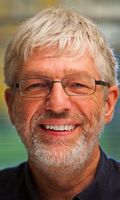Daylighting Chedoke Author John Terpstra on Scattering Seeds for a Great Title
Hamilton is well known for its natural beauty, from waterfalls to parks. However, one natural feature in the city is more hidden than the rest: Chedoke Creek runs through Hamilton but is mostly covered by development. It can be seen where it flows over the edge of the Niagara Escarpment and peeked at in a short stretch of canal beside the highway, but its charms have mostly been lost to history.
That's where John Terpstra comes in with Daylighting Chedoke: Exploring Hamilton's Hidden Creek (Wolsak & Wynn). He makes the story of the creek a fascinating one, drawn from a deep dive into historical sources and municipal documents. Using the creek as representation, he delves into our relationship with the natural world, environment issues, and the idea of the unknown flowing by everyday, just below our feet.
We're excited to welcome John to Open Book today to tell us about the significance of the title Daylighting Chedoke for our Entitled interview series. He tells us about how the title came to him, the titles that have stuck with him as a reader, and why a title is not the end all and be all of a book.
Open Book:
Tell us about the title of your newest book and how you came to it.
John Terpstra:
The title of my newest book is Daylighting Chedoke. It slipped in under the door like a water spill. Once it appeared, the title seemed obvious. I think and hope it is pleasant to eye and ear, in a poetic sort of way, and enticing too, because I know that both words need explanation for most readers. I hope they are attracted to the mystery.
OB:
Where is the most unexpected place you've ever found inspiration for a title?
JT:
The most unexpected place I have ever found a title was in my own head. It’s always a surprise to me that a good title will sometimes simply materialize out of nowhere. Nowhere is a bit of a misnomer, of course, since the title is usually an offshoot of having been immersed in a prose project or a poem so deeply that scattered seeds of thought and feeling have had time to germinate, and then one day pop up out of the soil and unfold the petals of their just-rightness. If you’re lucky.
OB:
What, in your opinion, is most important function of a title?
JT:
The function of a title is to wave a flag to attract the attention of passers-by; to put out a hitch-hiking thumb and catch a ride; to give a name to the vessel or craft you send out over the seas, so that when it is sighted a report may come back to you of its travels.
OB:
What is your favourite title that you've ever come up with and why? (For any kind of piece, short or long.)
Your CanLit News
Subscribe to Open Book’s newsletter to get local book events, literary content, writing tips, and more in your inbox
JT:
My own favourite title is the Christmas poem, The Little Towns of Bethlehem, because it plays on a very well known carol, with one extra letter that makes all the difference.
OB:
What is your favourite title as a reader, from someone else's work?
JT:
A title that I have always loved, because it is long, and unexpected, and possibly because I am the child of immigrants, and because it works so well, is The Avenue Bearing the Initial of Christ into the New World, a poem by the American poet Galway Kinnell.
OB:
What quality in a title will consistently make you pick up an unfamiliar book?
JT:
Very rarely have I picked up a book or read a poem simply because of the title. Some of my favourite poems have titles that have no resonance at all for me, like The Revenant, by Billy Collins. There are a lot of good titles in front of not so great books, too. I find what I want to read by other means. What are those means? Reviews, word of mouth, following my nose through the forest of subject areas that are of interest, finding trees just asking to be climbed.
OB:
What are you working on now?
JT:
At the risk of calling up the blank-page curse that comes into play whenever I say what I am working on now, I hereby tell the world that the file name of the document into which are being placed poems currently in the incubation process is, A New Slim Volume of Verse. A bland and functional enough title that it doesn’t represent too much of a risk. I hope.
___________________________________
John Terpstra is the author of ten books of poetry and four books of non-fiction. He often plays in that zone where human beings interact with nature – nature in the city, not the country. The nature he gravitates toward is one that has some experience of us, has had to live with us and our demands, and is no longer pure or whole or perfect, but still somehow manages to be itself – maybe even more than when it was “wild.” He is interested in how natural geography and built geography integrate and relate to each other, and in how history is simultaneous with now. Daylighting Chedokeis a companion book to his two earlier books about Hamilton as a living, breathing geographical location, Falling into Place and The House with the Parapet Wall.





